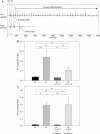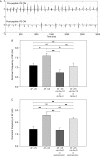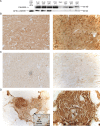Targeted G-protein inhibition as a novel approach to decrease vagal atrial fibrillation by selective parasympathetic attenuation
- PMID: 19457892
- PMCID: PMC2709464
- DOI: 10.1093/cvr/cvp148
Targeted G-protein inhibition as a novel approach to decrease vagal atrial fibrillation by selective parasympathetic attenuation
Abstract
Aims: The parasympathetic nervous system is thought to play a key role in atrial fibrillation (AF). Since parasympathetic signalling is primarily mediated by the heterotrimeric G-protein, Galpha(i)betagamma, we hypothesized that targeted inhibition of Galpha(i) interactions in the posterior left atrium (PLA) would modify the substrate for vagal AF.
Methods and results: Cell-penetrating(cp)-Galpha(i)1/2 and cp-Galpha(i)3 C-terminal peptides were assessed for their ability to attenuate cholinergic-parasympathetic signalling in isolated feline atrial myocytes and in canine left atrium (LA). Confocal fluorescence microscopy indicated that cp-Galpha(i)1/2 and/or cp-Galpha(i)3 peptides moderated carbachol attenuation of cellular Ca(2+) transients in isolated atrial myocytes. High-density epicardial mapping of dog PLA, left atrial pulmonary veins (PVs), and left atrial appendage (LAA) indicated that the delivery of cp-Galpha(i)1/2 peptide or cp-Galpha(i)3 peptide into the PLA prolonged effective refractory periods at baseline and during vagal stimulation in the PLA and to varying extents also in the LAA and PV regions. After delivery of cp-Galpha(i) peptides into the PLA, AF inducibility during vagal stimulation was significantly diminished.
Conclusion: These results demonstrate the feasibility of using specific G(i)-protein inhibition to achieve selective parasympathetic denervation in the PLA, with a resulting change in vagal responsiveness across the entire LA.
Figures






References
-
- Conway E, Musco S, Kowey PR. New horizons in antiarrhythmic therapy: will novel agents overcome current deficits? Am J Cardiol. 2008;102:12H–19H. - PubMed
-
- Jais P, Cauchemez B, Macle L, Daoud E, Khairy P, Subbiah R, et al. Catheter ablation versus antiarrhythmic drugs for atrial fibrillation: the A4 study. Circulation. 2008;118:2498–2505. - PubMed
-
- Pokushalov E. The role of autonomic denervation during catheter ablation of atrial fibrillation. Curr Opin Cardiol. 2008;23:55–59. - PubMed
-
- Arora R, Ng J, Ulphani J, Mylonas I, Subacius H, Shade G, et al. Unique autonomic profile of the pulmonary veins and posterior left atrium. J Am Coll Cardiol. 2007;49:1340–1348. - PubMed
Publication types
MeSH terms
Substances
Grants and funding
LinkOut - more resources
Full Text Sources
Other Literature Sources
Medical
Research Materials
Miscellaneous

